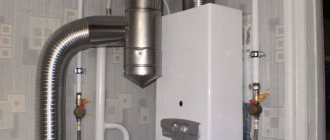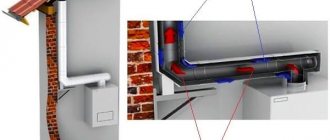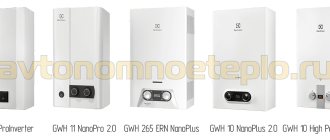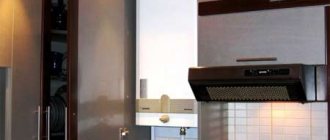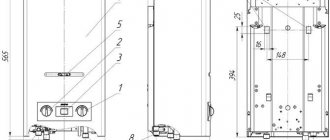The presence of a gas water heater in the apartment provides its residents with hot water. Just turn on the water heating device and a warm stream will flow from the tap.
The choice of such a device must be approached extremely carefully, taking into account the pros and cons of a gas water heater in the apartment.
How to choose a water heating device, does it need to be legalized, what are the installation requirements set by law, and how much does it cost to install a water heater in 2021?
What is important to know when choosing a gas instantaneous water heater?
Before moving on to choosing a gas water heater, you need to check whether the project provides for connecting a water heater in your home (whether there is a separate chimney shaft for water heaters).
This is an important question, because if there is no shaft, it is prohibited to install a gas heater due to fire safety requirements.
Before you buy a water heater, you need to know how to choose a gas water heater for your apartment. When choosing equipment, you need to pay attention to the following characteristics:
- Presence of a modulation burner. This type of burner ensures a constant temperature of the water leaving the column, regardless of surges in the incoming water.
- Speaker power. The amount of water that the column can heat depends on the power. The more power, the better. But at the same time, the price of equipment is also rising.
- The process of turning on the column. Gone are the days when people, burning their fingers, lit gas in old Soviet water pumps using folded paper or matches. To turn on modern speakers, all you need to do is press a button or simply open a water tap. There are 2 options for turning on the column: the first is piezo - to turn on the gas you need to press the button; the second is electronic ignition - the gas turns on automatically when you turn on the water tap. Water heaters with electronic ignition are economical because there is no igniter with a constantly burning flame.
- Water consumption is the amount of water that heats up to 25 degrees per minute.
- The number of water points - points that provide simultaneous supply of hot water. The actual flow usually does not exceed 6 liters of water per minute. This amount of water is considered to be the consumption of 1 water point. For example, with a flow rate of 10 liters of water per minute, the water heater is capable of providing 2 water points in the summer and 1 point in the winter. With a water consumption of 13 liters per minute - 2 water points all year round.
- Type of gas used (natural, liquefied). For an apartment you need to choose a heater that works with natural gas. If, for example, we are talking about a cafe in which there is no connection to a centralized gas supply, then you need to choose a dispenser that can operate on liquefied gas in cylinders.
- Water heater chimney diameter. This indicator should not be larger than the diameter of the inlet or the chimney itself built into the building.
- It is prohibited to use non-certified, plastic or corrugated air ducts to remove combustion products, since the average temperature of the exhaust gases is more than 100 degrees Celsius.
- The material from which the column is made. All heat exchangers are made of copper, but some manufacturers use low-quality copper with the addition of impurities of other metals and substances (for example, coated with a lead alloy). A copper heat exchanger made of high-quality copper is safe for health, since it is more environmentally friendly and does not emit lead oxide into the air, which settles in the apartment.
- Burner type. Preference should be given to models with European burner designs, as they meet the highest requirements for environmental friendliness and safety.
- The column controls are push-button, with knobs, with temperature displayed on a digital display.
Cost of work
If you first need to dismantle the old column, such work will cost you 300-800 rubles, but you can save money and do the dismantling yourself. The cost of installing new equipment will be influenced by the brand of the dispenser - connecting a device from a domestic manufacturer costs less (from 1,500 rubles) than installing an imported dispenser (from 1,700 rubles).
Related article: How to wallpaper beautifully
The list of works will also affect your expenses - if you need to prepare the base for installing the device, and then connect the column “from scratch”, the price will be the same, if everything is already prepared and you hung the device yourself, have already connected it to the water supply, and all that remains is the supply gas, the price will be much lower. On average, you need to pay 3000-6000 rubles to install a speaker.
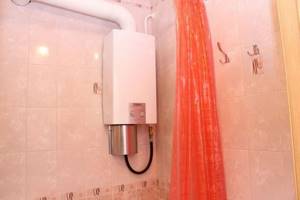
How to replace an old gas water heater with a new one?
Over time, the need arises to replace the old gas water heater with a newer, modern, modernized one. Where to go to upgrade your direct water heater?
To do this you need:
- Buy a certified heater.
- Obtain from the housing office/management company copies of the water and gas supply system, where the installation locations of the device will be indicated.
- Contact the gas service with an application to replace the gas water heater while maintaining its installation location.
- Wait for the gas service employees to arrive, who will install the equipment and issue a certificate of commissioning of the device.
If the owner of the apartment decides to change the gas water heater, and even install it in another place, then the procedure becomes more complicated, since it will be necessary to change the gas, water and air supply circuit.
To install new equipment in another location, you need:
- Contact the fire inspectorate and get a report on the condition of the chimney.
- Order a project for moving the column from the gas service.
- Obtain permission for redevelopment from the municipality. When submitting an application, you must have with you a project, an act, a permit, a technical passport for the pump, and a document confirming ownership of the apartment.
- With all the documents listed above, the owner must contact the gas service.
- Having received the application and reviewed the client’s application, gas service employees must install and connect the equipment and carry out the first start-up of the device. After this, they must seal the meter and issue the owner of the apartment with a certificate of commissioning of the dispenser.
- After installing the dispenser, the owner must contact the BTI, informing this service about moving the dispenser to a new location.
How to obtain permission to install?
If the kitchen complies with all the rules and regulations for installing a gas water heater, then the owner needs to obtain permission to install a water heating unit.
To do this he needs:
- To prove ownership of housing - contact Rosreestr to obtain the appropriate extract.
- Contact the BTI or Rosreestr and request an apartment plan there. This document will confirm that the kitchen parameters comply with the requirements that govern the installation of geysers.
- Contact the gas service with an application to connect the water heater.
- Go to the design office to receive a new project for a branch of a new internal gas pipeline.
- Having a project and permission from the gas service in hand, the owner has every right to contact a contractor who can install a tap for the water dispenser.
- After installing the equipment, you need to invite gas service specialists to connect the column and put the appropriate mark in the device’s passport.
Connecting gas equipment
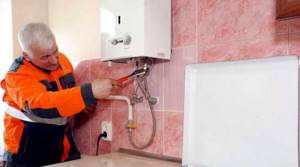
In apartment buildings, using gas to heat water and cook food is fraught with danger, so connecting the equipment to the gas pipe yourself is not allowed.
Conditions for starting work after replacement:
- if the dispenser is installed and connected by a suitably qualified specialist, permission is required for commissioning and fuel supply;
- gas organization employees check the functionality of the system before starting and document the permit.
Before installation, a package of documents is collected. Its composition differs depending on whether the column will be installed in its old location or whether it is planned to be moved.
How to apply, where to apply

The user applies to a gas management company servicing a home or private sector. Installing a column in its old location does not require drawing up a project, since the relevant documents were developed during the initial installation.
In an organization, the owner makes two statements :
- to replace the instantaneous water heater model with a new one and install it in the same place;
- for issuing a permit to work with city water and gas mains.
If replacing a gas water heater involves moving it to another location, the network needs to be rebuilt. In this case, they order a project and fill out the same papers as during the initial installation.
What you can do yourself
Only licensed and authorized specialists connect gas pipes to any equipment. The owner can remove the old heater with his own hands . It is allowed to connect it to cold water pipes with your own hands.
To do this you need:
- close the valve at the entrance to the apartment;
- disconnect all connections of the speaker, remove it from the wall;
- hang a new kitchen unit.
forbidden to turn on the shut-off valve before the technicians arrive .

The gas supply valve cannot be turned on independently.
Installation Rules
The homeowner does not need to know how to install a gas water heater in an apartment, since the installation must be carried out by a specialist who has the appropriate skills.
But the owner of the apartment needs to know what documents should be prepared and what authorities to contact so that the equipment installation procedure is correct and legal:
- Study the documents for the apartment. In some houses it is prohibited to install speakers. For example, if the apartment is located high up or we are talking about installing a water gas heater in a studio apartment, then it will not be possible to install the equipment.
- Buy a certified geyser in accordance with your requirements and wishes.
- Obtain from the management company diagrams of the water and gas supply system, where the installation location of the equipment will be marked.
- Contact the fire inspectorate with an application to issue a report on the technical condition of the chimney.
- Go to the gas service, be sure to take all the necessary papers with you. The chairman of the management company can tell you what documents gas workers need: an application, title documents for the apartment, chimney duct design, apartment plan (taken from the BTI), passport of the apartment owner, documents for the pump.
- Wait until a gas service specialist arrives on the appointed day, installs the equipment and issues a certificate of commissioning of the dispenser.
Basic installation safety rules
It is required to follow many rules and features when installing a gas water heater and water heater. Otherwise, owners may be fined large sums.
It is important to equip the chimney and ventilation system. The efficiency of moving air flows, as well as the timely removal of smoke from the room, depends on this
It is strictly forbidden to install the unit above a sink, refrigerator, or gas stove.
The ventilation hole must be of such a size that air can easily pass in the required quantities without clogging the main components of the system. If you forget about this requirement, then over time a large amount of toxic substances can lead to emergency situations, as well as poisoning of all residents in the house. The risk of gaseous waste explosion increases. This is especially true at night, when people are physically unable to detect a gas leak in the house.
Access to the gas water heater should be as free as possible. This will ensure quality service and the ability to inspect the device if necessary.
In order for the gas water heater to function normally, it is necessary to arrange a passage to the chimney. It can be connected to a common main line or mounted independently. During installation, it should be taken into account that the number of bends for normal air flow should not exceed the established norm. Otherwise, difficulties arise with transporting air flows to the outlet. The length of the chimney is established by law. Otherwise, a chimney pipe will be required to ensure normal levels of air circulation.
Do not mount the device too low or high.
The installation location of the gas outlet pipe is located in such a way as to provide optimal outlet for the column. For installation, you should use pipes that are made of substances that are resistant to combustion processes. Increased risk of fire. The best option would be pipes that have a low degree of thermal conductivity.
The pipe is usually connected in a vertical position. The length of this section is at least fifty centimeters for normal operation of the installation. In some cases, it is permitted to use corrugated pipelines. There should not be any sagging or unevenness.
It is advisable that the boiler be at eye level or at least within sight.
If it is not possible to install a chimney, you need to take care of another method of removing gases. For example, you can install a powerful hood that has sufficient draft to remove gas outside. It is necessary to arrange the system in accordance with the design documentation.
Many owners of houses and apartments have a natural question whether it is possible to cover the gas water heater with a cabinet. It can be done
At the same time, it is important to follow certain rules for placing the dispenser so that there are no problems with the gas service
It is better not to decorate the walls near the speaker with wallpaper and plastic panels. The surface on which installation is to be carried out must be covered with non-flammable materials.
The water heater must not be connected to a load-bearing wall. You also cannot install the column using this method. This can be explained by the fact that in the event of an explosion the entire house could collapse. To clarify this issue, you should contact specialists. They will conduct research of the area, which will help determine the method and location of installation of the structure.
It is also necessary to follow certain rules for placing the system. Treatment of the area in the stopping area must be made from materials that are resistant to combustion. This will help prevent the possibility of a fire. The structure cannot be installed on wooden surfaces. This will require pre-processing.
In the room where the heater operates, you should not overdo it with waterproofing and insulation of windows.
To achieve high safety of the geyser, you should not install it above other gas appliances. It is recommended to keep your distance. It is necessary to carefully check the sealing of each channel and install the pipes in accordance with legal regulations.
Standards for placing a gas water heater in an apartment
It is important to adhere to the rules for installing a geyser for fire safety purposes:
- room standards: the kitchen area must be at least 7.5 square meters. m.; the minimum ceiling height in the apartment is 2 m;
- chimney opening diameter – not less than 120 mm;
- the column must be mounted on a brick or concrete wall, and for better protection (to avoid fire), it is important to install galvanized sheets during installation;
- natural ventilation is a prerequisite for installing a column;
- It is prohibited to install the device directly above a gas stove;
- the column must be placed at a distance of at least 1.5 m from electrical appliances;
- An extractor hood for a geyser in an apartment must be installed in the kitchen, since combustion products must be vented outside. In the apartment, these products are removed through the ventilation duct. According to the standards, no more than 2 units can be connected to one hood. And you can install the hood only near a wall made of non-combustible materials;
- Special sensors must be present so that they can be used to monitor the presence of combustion products in the air. This is necessary so that when the level of combustion products in the air exceeds the level, the sensors can turn off the gas supply or notify residents of the problem;
- in the kitchen where the gas water heater is located, there must be a door;
- It is prohibited to mask gas pipes and the column itself. Gas technicians should always have easy access to equipment and pipes.
Requirements
The place where the column will be mounted is chosen taking into account the arrangement of the hood and compliance with other standards, as well as taking into account the provision of communications and ease of use.
There are the following requirements:
- The room for the location of the gas water heater must be non-residential, have an area of at least 7.5 m2 and a ceiling height of at least two meters.
- It is important to ensure sufficient ventilation in the room (a window is required).
- The pressure in the water supply pipes should be from 0.1 atm.
- Installation must be carried out on a fireproof wall made of concrete or brick, then insulation of the surface is not necessary. If it is carried out on a fire-resistant wall, then basalt heat-insulating cardboard 3-5 mm thick and galvanized sheet 0.8-1 mm thick can be used to cover the wall to make it non-flammable. In this case, the insulating material must protrude beyond the boundaries of the column by at least 100 mm on all sides.
- Installation of speakers on walls made of wood or walls with flammable coating is prohibited.
- The side panel of the device should be located no closer than 15 cm from the wall.
- There must be free space in front of the front panel of the device (minimum 60 cm).
- The minimum distance from the water heater to the gas stove is considered to be 10 cm.
- To supply water and gas, flexible hoses or metal pipes with an internal diameter of 13 mm and a length of up to 2.5 m should be used.
- Before installation, a shut-off valve must be installed on the column.
- The chimney intake duct must have a circumference of 120 mm in diameter.
- The diameter of the pipe removing gas from the column should be from 110 mm, and the length – from 300 mm to 2 m. In addition, the pipe is placed with an upward slope of at least 2 degrees.
Article on the topic: finishing screed (filling) of the floor with your own hands: the screed process
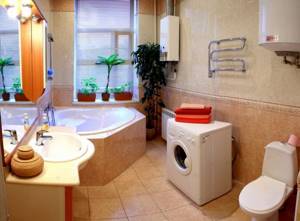
Moving the speaker to another location, changing the device
How to legalize a gas water heater in an apartment if the owner decides to move it to another place in the kitchen? To do this you need:
- Change the water, gas and air supply diagram. To do this, you need to contact the city gas service and order a project for installing equipment in another location. You can also contact a private organization that has a license to carry out such activities.
- Go to the fire inspectorate and ask for a report on the condition of the chimney. Don’t forget to always take documents with you to the apartment and to the pump.
- The owner of an apartment in an apartment building must obtain permission for redevelopment from the municipality.
- Together with the permit, act, project, technical passport for the pump, documents for housing, the owner must again contact the gas service with a request to install gas equipment.
- On the appointed day, a specialist will come and install, connect the new column, and make the first start. After this, he will seal the meter and issue the owner with a certificate of commissioning of the device.
- The owner must contact the BTI and notify about the transfer of gas equipment.
How to install a column and who should do this work?
It is better to leave the connection of the dispenser to the gas distribution system to the gas service, but the preliminary installation of the device (connection to the water supply and installation on the supporting surface) can be done with your own hands.
To do this you need to do the following:
- Drill a hole in the wall.
- Insert a coaxial chimney into it and fill the voids with non-flammable insulation (mineral wool).
- Tile the wall under the hole.
- Secure the column to the tiled area (on top of the tiles) using brackets on its body and dowels.
- Cut a tee into the cold water supply, screw a valve and a check valve onto the free end.
- Connect the check valve to the cold water pipe/fitting on the column body.
- Place a manifold with shut-off valves over the cold branch of the water supply system - it will distribute the hot flow along the lines leading to sources of consumption (taps and mixers).
- Connect the manifold and the hot water pipe/fitting on the column body.
- Arrange lines from the collector to the taps and mixers.
After this, you can contact the gas service - completion of the work on connecting the column, including the first start-up of gas and water, is carried out by gas specialists.

The connection and first start-up of gas must be carried out by a gas specialist
Well, if you are not going to do something yourself, find a company with permission to install gas-consuming appliances and order the services of experienced specialists.
Who can install a gas water heater?
Some owners are interested in: “Is it possible to install a water gas heater yourself?” The law clearly establishes who should install a gas water heater - only a specialist with the appropriate license.
The fact is that gas is potentially dangerous if used incorrectly, so any work related to the transfer or installation of the column must be carried out by a specialist.
For self-installation of equipment, administrative and criminal liability is provided:
- the service provider can cut off the intruder from the gas line;
- the fine for self-installation of equipment can reach up to 45 thousand rubles;
- if, as a result of self-installation of a gas water heater, an accident occurred in which people died, then the owner of the apartment may face a prison sentence of up to 5 years.
How often should the column be changed?
Water heating geysers are durable devices. The service life of a new unit is on average 10-15 years. It is influenced by the following factors:
- quality of heated water;
- presence of a filtration system;
- manufacturer's reliability.
All heating equipment is subject to annual scheduled inspection. This is done by service center specialists or local gas workers. With high-quality maintenance and timely replacement of consumables, the device will last a long time.
Common Mistakes
Our people are not afraid of fines for unauthorized installation of water heaters, so water heating equipment is often placed incorrectly in apartments.
However, experts strongly do not recommend making such mistakes when installing a geyser:
- The speaker cannot be placed in the bathroom, since there is no natural ventilation in this room (no windows).
- There is no need to hide the unit in a closet - this leads to disruption of the functioning of the device.
- You cannot connect the gas yourself. Some people confuse a water pipe with a gas pipe. If water gets into the main line, this can lead to equipment failure, stopping the gas supply not only to the person who made the incorrect connection, but also to all neighbors of the house.
Steps to take when replacing a gas water heater
If gas water heating equipment fails or it is decided to replace it with a more modern model, then the following nuances should be taken into account:
- It is forbidden to connect the gas water heater to the gas supply system independently;
- the basic requirements for the placement of the device are described in building codes and installation rules 42-01-2002 and SP 42-101-203;
- To replace or install, you will need to collect the necessary documentation.
It is worth considering that to replace a flow-through heater you will need one set of documents, and to transfer or initially install another. The area of the room where it will be mounted must be at least 8 m². Gas water heaters are not installed above the 11th floor.
First you need to select a model, then collect a package of documents. After collecting all signatures and agreeing with specialists, the old installation is removed, then a new column is installed.
Pros and cons of a gas water heater in an apartment
When deciding whether to install a gas water heater in an apartment or prefer a boiler, it is important to note all the advantages and disadvantages of this method of heating water.
Pros:
- there is always hot water;
- you can quickly heat a large amount of water;
- no need to pay for hot water;
- You can connect home heating to the column (if the column is double-circuit).
Minuses:
- explosion and fire hazard;
- the presence of a gas water heater requires good draft (if there is no draft, there is a risk of carbon monoxide poisoning);
- a chimney and good ventilation are necessary - this point must be taken into account when designing a kitchen.
Installing a gas water heater in an apartment is a serious undertaking that requires obtaining the necessary permits and knowledge of which water heater to buy, whether the device can be installed in an apartment building, where to go, how to install it correctly, etc.
The installation of a gas water heater should be trusted only to specialists - only they know exactly how to install the equipment correctly in accordance with the rules and regulations.
It is prohibited to install the water heater yourself, otherwise the apartment owner will face administrative and/or criminal liability.
Is it possible to hide a gas water heater in a closet and where can it be hidden?
When installing a speaker in the kitchen, homeowners often think about hiding the device from view, but they doubt whether it is allowed to cover such a device with furniture.
A gas water heater can indeed be hidden in a closet, but such furniture should have no bottom wall so as not to interfere with the ventilation of the equipment. Also, such a cabinet should have no back wall. In addition, its side walls must have good fire protection.
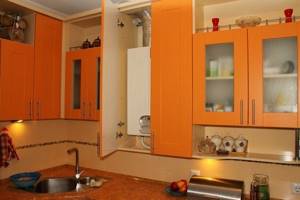
Operating rules
In order for the new column to serve for a long time and not require repairs, you need to:
- Carry out regular maintenance, cleaning the device from carbon deposits, dust and scale. The recommended frequency is once a year, but if it gets dirty, unscheduled cleaning can be done.
- Avoid excessive heating of the water in the column, as this accelerates the process of scale formation on the walls of the heat exchanger.
- If necessary, install a filter and pump in front of the column.
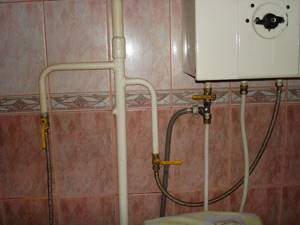
You can see an example of installing a gas water heater in the following video of the “Yury Trifonov” channel.
Types of water heaters and boilers for apartments
If we talk about gas heaters, they can be flow-through or storage. But in Russia, gas boilers are not widely used, because they are less convenient, cost more and take up a lot of space . They should only be installed if the gas supply is too weak. Mostly they install instantaneous gas heaters.
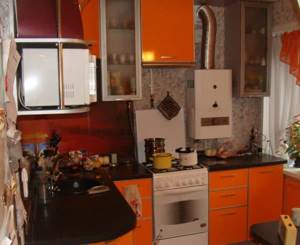
It’s not easy to install a geyser: you need to comply with safety requirements and you want to fit it beautifully into the interior
Modern models may have a closed or open combustion chamber. Open ones are a little safer and require less paperwork during installation. They are needed if there is no chimney in the house. The latter are suitable if the old heater is being replaced with a new one, the chimney and gas supply have already been made and tested.
Suppliers offer 3 types of power. 17-20 kW is needed for a one-room apartment with 1 inhabitant. If a person takes a shower, there is no longer enough power to wash dishes. Devices with a power of 20-26 kW are indispensable for apartments. They provide 15 liters of water per minute at a temperature of 40 degrees. The power of an average heater is enough for a family of 4 people and an apartment with 1 shower and 2 sinks. A power of 26-28 kW is suitable for two-level apartments or houses.
